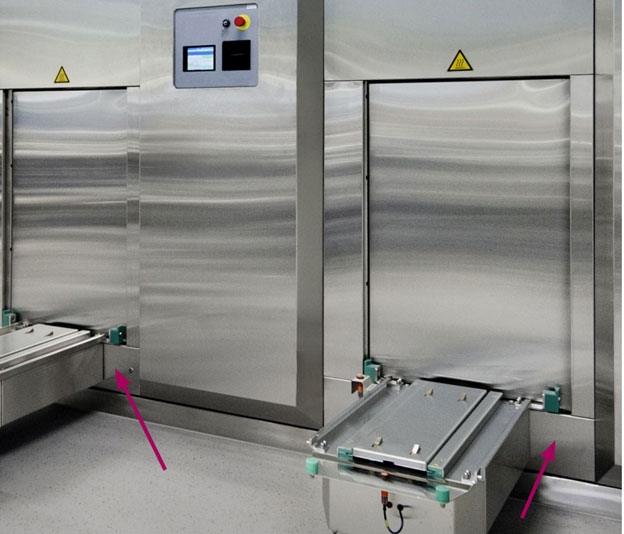Increase productivity and safety of your processes with 80 GHz radar sensors
When it comes to finding the right level technology for the specific needs within your industry, it can be a […]
Medical autoclaves and steam sterilizers rely on accurate, precise, and reliable temperature measurement to function effectively and meet stringent life sciences industry regulations. Ensuring these standards are maintained requires frequent instrumentation calibration, but there are several risks associated with standard procedures. New instrument technology addresses this and other issues by using automated calibration.

This greatly increases calibration frequency, while reducing the need for time-intensive manual calibrations. The Endress+Hauser iTHERM TrustSens TM371 and TM372 smart temperature instruments perform fully automated in-situ self-calibration, providing:
It is standard practice in medical autoclave operation to monitor temperature by placing an instrument’s sensor in the drain or near the bottom of steam sterilization equipment, the least hot locations. Because measuring instruments are inevitably subject to age-induced drift or mechanical damage, periodic recalibration is necessary to guarantee accuracy. But when inaccuracies are found, there is no way to quickly identify the timespan and batches impacted between manual calibration cycles, creating lengthy and costly troubleshooting efforts. In the worst case, batches must be discarded due to inaccurate temperature measurements.
Additionally, manual calibrations involve process interruption, manual intervention, instrument removal, and associated risks—like mechanical damage.
Endress+Hauser’s iTHERM TrustSens pharmaceutical grade temperature sensors incorporate a high-precision reference, known as a “Curie Point,” that experiences an abrupt ferromagnetic change at a certain “Curie Temperature.” The change in properties can be detected electronically by the instrument’s transmitter, triggering an automated process value checkpoint upon reaching the Curie Temperature.
Because this checkpoint is triggered by a material property, it guarantees an immutable reference. The instrument automatically creates a digital calibration record each time the Curie Temperature is reached during production by comparing its measured primary process value at the immediate moment to the Curie Temperature. If the process value deviates outside acceptable boundaries, the instrument’s transmitter issues an alert to personnel, indicating the need for sensor replacement.
This self-calibration makes it possible to continuously and repeatedly monitor changes to the instrument’s sensor and transmitter. Additionally, results align directly with the true application, whereas laboratory calibration can only emulate real-life ambient and process conditions. These instruments create and store online calibration certificates, making it easy for technicians to review calibration history, and even securely share compliance data via a local network or in the cloud.
Leveraging the HART communication protocol, iTHERM instruments can transmit process and diagnostic data—such as number of calibrations completed, calibration deviation factor, and sensor heartbeat—directly to a central process control system or to a data manager for regulatory compliance.
By continuously querying these values, an alarm system can generate notifications when a calibration deviation exceeds an established limit. Because calibration events and deviations are time-stamped, plant staff can immediately determine which batches are compromised.

A global healthcare company seeking a streamlined operations approach at its sterile facility replaced its antiquated temperature instruments with Endress+Hauser iTHERM TrustSens TM371 and TM372 smart temperature instruments to update its facility-wide calibration procedures. Previously, the company performed all calibration manually, but these efforts required removing sensors from service. This exposed the sensors to hardwiring errors and mechanical mishaps, and the process to biological contamination. Additionally, each sensor required calibration every six months to maintain measurement integrity, creating frequent planned downtime, and in some cases unplanned downtime due to unexpected failures.
The new instruments perform automatic, in-situ calibration during every batch, empowering the company to greatly relax its manual calibration requirements and reduce risks.
The Endress+Hauser solution also provided:
The Curie Temperature point of 118°C is very close to the required sterilization temperature of 123°C, guaranteeing automated calibration twice during every batch—once during temperature increase toward the steam sterilization target, and a second time during temperature decrease post-sterilization.
The online calibration certificates provided the company with traceable documentation, so they can easily report instrument data to the FDA and other regulatory bodies. During a one-month monitoring period, the instruments performed an average of 80 successful in-situ self-calibrations each, two calibrations per workday.
In the case study above, the facility’s temperature instruments now undergo nearly 1,000 automatic calibrations each year. Combined with two manual calibrations per year, not only is there a significant reduction of calibration effort and risk, but the new calibration frequency also greatly enhances measurement integrity.
These benefits, combined with automatically-generated and stored calibration records, expedite faulty sensor discovery, increasing batch integrity and overall equipment effectiveness. Endress+Hauser smart instrumentation empowers plant personnel to achieve maximum uptime, while maintaining regulatory compliance and guaranteeing every batch is sterile.
When it comes to finding the right level technology for the specific needs within your industry, it can be a […]
Instruments are vital in process environments because their measurements directly impact product quality and operational safety. However, even the most […]
The measurement of TOC (total organic carbon) in water is of vital importance to a multitude of industries that need […]
Comments